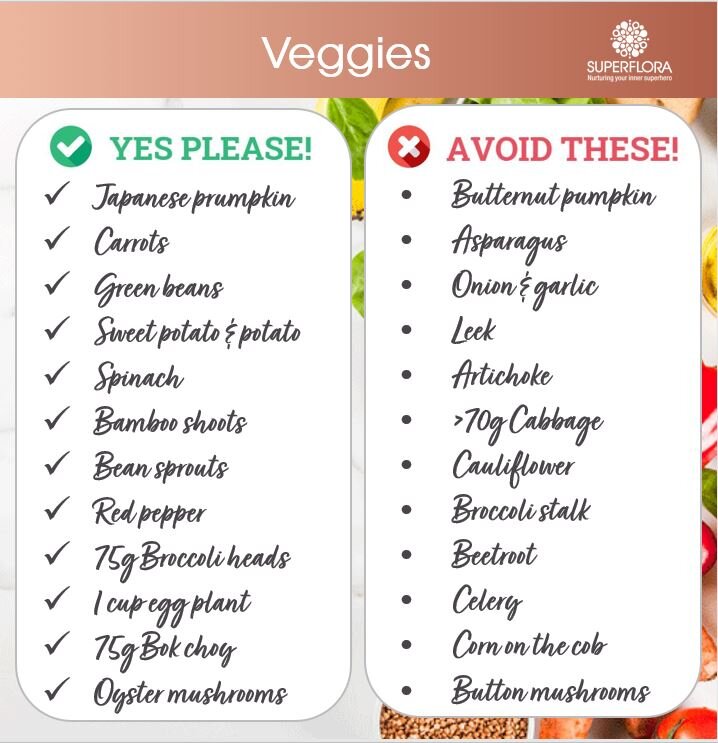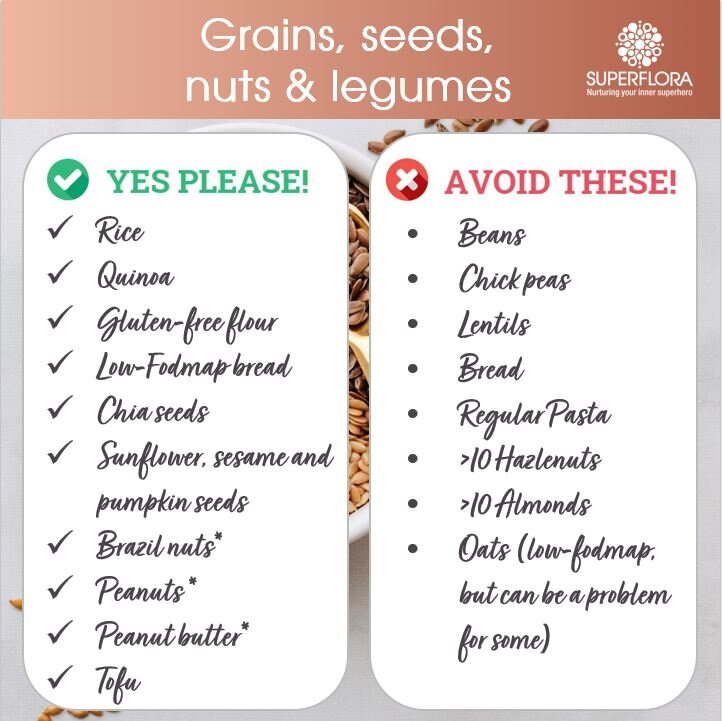How to test whether a low fodmap diet will help your gut, without turning your pantry upside down
Have you ever been told to try a low fodmap diet to improve your gut health? There are lots of clinical studies showing that a diet low in fodmaps can be effective in reducing symptoms in people living with IBS, IBD, diverticulitis and other gut health issues.
But starting a low fodmap diet can be overwhelming. And there are no guarantees that it will help improve your gut health.
Is there an easier way to work out whether going lofo will work for you before you turn your pantry upside down?
Yes. In this blog, we’ve put together a simplified plan that you can implement without facing a family revolt. Or getting a PhD in biochemistry.
A simple food guide - what to avoid and what to enjoy
We’ve put together a simple food guide so you can swap in low fodmap foods and swap out high fodmap foods most likely to trigger gut health symptoms. With some easy switcheroos, you’ll be able to keep cooking your favourite recipes without your family noticing (too much).
Remember, this is beginner’s guide to test whether or not you should embark on the full three-phase low fodmap diet. Using a simplified approach restricts foods that are very high in fodmaps and are suspected to be major symptom triggers.
If your symptoms improve over 2-3 weeks, maybe you just need to avoid high fodmap foods that trigger your symptoms. Easy!
We recommend that you then work with a dietitian, and the Monash Fodmap or Fodmap Friendly apps to work out which of the six fodmap groups are a problem for you. You may be able to widen your food options further.
If your symptoms don’t improve, then you should again discuss your findings with a dietitian. You can find a list of fodmap trained dietitians here
So let’s focus on finding gut-safe substitutes for dairy, fruit & veg, grains, sugar and spice.
What’s so scary about avoiding dairy?
Sadly, the lactose in dairy products can trigger gut health symptoms. Going lofo means temporarily avoiding milk, soft cheeses, ice cream, cream and sour cream. The good news is that there are lots of lactose-free dairy products available at your local supermarket.
You can swap cow’s milk for soy or almond milk. And these dairy coconut yoghurts are delicious – Nakula, Cocobella and Cocome. But check your coconut yoghurt label to ensure it doesn’t contain inulin, which is a nasty fodmap.
Whilst you will have to temporarily swap out cottage cheese, you can still enjoy a small serve of camembert, a couple of slices of a hard cheese like cheddar and up to 40g of feta. These are actually low in lactose and shouldn’t cause problems.
Butter is low in fodmaps, but we’d still recommend swapping butter for olive oil. This is better for your heart. Some people with IBS find that whilst fat and oil don’t contain any fodmaps, they can cause gut symptoms.
Easy low fodmap dairy swaps
An apple a day may not be the way
Reaching for that apple? There are lots of fruits that you can enjoy on a low fodmap diet such as oranges, mandarins, strawberries, grapes and kiwis. But apples, apricots, ripe bananas, melons, cherries, figs, dried fruits and fruit juices are all out.
There are many fruits you can enjoy on a low fodmap diet.
Many people take an apple or banana to work as a snack. They are convenient and come in their own ready-made packaging. Try 2 kiwi fruits instead. There is plenty of evidence to show that the fibre content in kiwis helps with constipation. Easy peeling citrus are another great option and whilst experts say that green bananas are fine, we really can’t get past the leafy green flavour!
Our favourite fruits are berries. Adding 5 medium strawberries, or a small serve of raspberries or blueberries makes every breakfast or desert taste better.
Low fodmap granola with blueberries makes an easy breakfast.
Add some dairy-free yoghurt and toasted nuts and you have a tasty and satisfying breakfast. If you want some extra sweetness, skip the honey and use maple syrup instead. .
Veggies to avoid
Veggies – Asparagus should be avoided and also be careful with the cabbage family - broccoli, cauliflower, cabbage, (cooked or in coleslaw and sauerkraut), brussel sprouts and the onion family – onions, garlic, shallots and leeks.
The thought of giving up garlic and onion might bring you out in a cold sweat. Don’t panic. Ýou can use the green tops of spring onions along with garlic-infused olive oil as substitutes. And weirdly a small portion of broccoli trees (heads) and the stalks of broccolini are both OK (if you can remember which way round that goes without checking you are doing better than most!).
Other gut-safe veggies are carrots, green beans, carrots, spinach, sweet potato, zucchini -some of these you have to limit portion size, others you can gorge.
You will find that you eat a lot of carrots on the low fodmap diet. They work raw and cooked and in a range of cuisines. Carrots and zucchini grated into a Bolognese sauce instead of onions work really well and the kids will hardly notice the difference.
Pumpkins are an odd one. Butternut pumpkins are to be avoided, but 75g of Japanese or Kabocha pumpkin (if you can find it) is fine. If you don’t want to avoid pumpkin, remember to look for Halloween-style pumpkins when you’re in the veggie aisle.
There are lots of colourful low fodmap vegetables.
Salad Days
Unfortunately, that great Aussie favourite beetroot is a no-no, at least in the home-cooked form. You can have a small serving of pickled beetroot (75g) or canned beetroot (60g).
And we repeat again to avoid brown or red onions, but you can swap in the green tops of spring onion. Yes, they go with everything.
A zingy low fodmap salad full of vitamin C and iron.
Lettuce and cucumber are both low fodmap so continue to use these as a base for a green salad, along with a small serve (75g) of spinach, (43g) red pepper and a slither of avocado (1/8th avocado is low in fodmaps, but higher serves contain sorbitol so don’t indulge).
We like to combine, spinach, roasted red peppers and orange segments for a beautiful zingy salad. You can add a little feta and a handful of olives for a more Mediterranean twist.
You say tomato, and I say tomat - ow!
Tomatoes are a bit fiddly – small servings are fine, but larger serves can cause problems and the serving size depends on the type of tomato you want to eat. If you’re eating common variety tomatoes 65g is fine. For rosa tomatoes a 48g serving is a low in fodmaps. If you’re eating cherry tomatoes, the serving size is smaller at 45g.
You need to limit tinned tomatoes to 100g per person, so a large tin shared between four for a Bolognese sauce should be fine, but you may need to omit tomato paste or you will start ‘fodmap’ stacking. This is where the fodmaps from low (rather than no) fodmap foods can start to add up.
Avoid ready-made tomato pasta sauces that contain onion and garlic. But did you know that there are low fodmap companies that make low fodmap sauces? Try FodShop or Fodmapped For You.
There are a wide range of low FODMAP salad vegetables
Herbs and spices
Herbs add flavour to any dish. We love to grow and gather them fresh from the garden. On the safe list are basil, coriander, ginger, lemongrass, marjoram, mint, oregano, parsley, rosemary and thyme. Chilli is a funny one. An 11cm section of chilli is a low-fodmap serving, but the capsaicin that gives the heat can also cause tummy problems, so use your own judgement on this one.
Coriander seeds are also fine and ground turmeric and nutmeg. You may be able to find Asafoetida powder in your local Asian grocers – many sites say you can swap this for onion. We aren’t convinced about the taste! Using the green tops of spring onions is probably easier.
Small serves (2 tablespoons of soy sauce) along with a dash of lime juice and maple syrup can make a lovely Asian-style dressing for Thai salads or stirfries.
There are many low fodmap spices you can use in baking or curries. Natural sweeteners and dark chocolate can provide a low fodmap sweet treat.
Other plant foods
Beans and legumes are on the no-no list, so avoid beans, chickpeas and lentils. However, rice and quinoa are both OK. You can end up eating a lot of rice on the low-fodmap diet. This can get boring. We recommend trying red, black, brown and green rice. These are low GI and have more fibre.
Limit hazelnuts and almonds to small servings of 10 nuts. However, brazil nuts, peanuts and peanut butter are fine and a great source of protein.
People often ask, “Can I eat these on a low fodmap diet?”.
Breads, pasta and cake are a problem unless made with gluten-free flour. This isn’t because of the gluten, but the fructan found alongside the gluten in grains. The good news is that you can now find low-fodmap bread at Bakers Delight.
The widely available, dried, gluten-free pastas taste just fine.
Sunflower, sesame and pumpkin seeds are also on the safe list.
Our Plant-Based Chocolate Superflora is great souce of additional protein if you are following the low-FODMAP diet. Like the rest of teh Superflora range it has been tested and certified low FODMAP by Monash University.
Kiwi and chia puddings
Chia seeds are an absolute winner. Mixed with coconut milk and sweetened with maple syrup they make a beautiful chia pot breakfast. We love to use Australian Chia seeds from The Chia Co in our shakes and in our deserts.
Sweet enough?
Avoid sweeteners ending ol – e.g., sorbitol, mannitol, maltitol and xylitol.
You can have old fashioned sugar (in small quantities), and maple syrup or maple syrup sugar. Golden syrup is also fine, but swap out honey.
Fire up the Barbie
If you are a meat eater, you’ll find that protein intake isn’t a problem. Meat is low-fodmap, as well as fish and seafood.
A low-fodmap life is definitely harder for vegetarians. As mentioned above chickpeas, beans and lentils can be a problem, but you can have a small serve (170g) of tofu and eggs are a winner for dinner.
Simple swaps for 2-3 weeks - are you ready to try it?
Keen to try? Making some simple substitutions over a 2-3 week period will help you determine if a full low fodmap diet is worth considering. If you think the lofo life is for you, we recommend getting help from a dietitian to ensure you’re eating a balanced diet and to determine which foods trigger your gut health symptoms.
Want low fodmap recipes and options?
Check out our tried and tested low fodmap recipes. We have gathered a selection for the 10 day meal plan in our Good Gut Challenge.
The challenge also includes our Superflora gut-friendly shakes as quick and easy low-FODMAP options for breakfast or lunch.










